
The Rocky Mountains.
Part 14. The Northern Rockies
| The Rocky Mountains go way up north, across much
of Canada. My favorite part is the area of Banff and Jasper Nat. Parks in Alberta,
Canada. |

Moraine Lake, Banff National Park. |
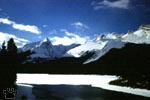
Jasper National Park.
It is one of the most scenic places in the world. |
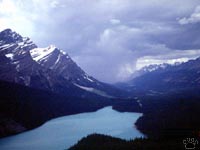
Lake Peyto, Banff National Park. |
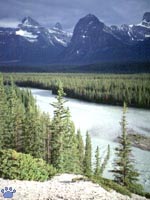
Goat Lick,
Jasper National Park, Alberta |
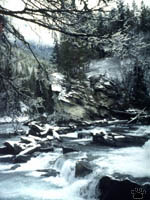
Frasier River Falls,
Yoho National Park, British Columbia |
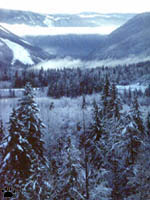
Winter morning,
Jasper National Park, Alberta |
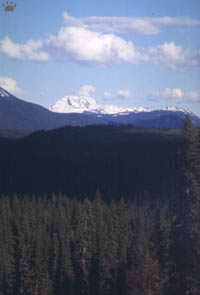
Mt.Robson from the north, British Columbia |
Mount Robson is the highest in Canadian Rockies,
and one of the most beautiful.

Mt.Robson from the south, British Columbia
The northernmost part of the Rockies from Mt. Robson to Yukon River headwaters
is the less visited one. |
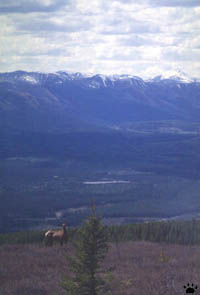
Elk on the summit of Pink Mt., Brit. Columbia |

Stone Mountain Provincial Park, Brit. Columbia. |
Part of Alaska Highway that passes through these
mountains (from Fort Nelson to Watson Lake) is very spectacular, and a good place
to see wildlife, such as wild sheep. |

Muncho Lake Provincial Park, Brit. Columbia. |

Newborn mule deer fawns,
Devil's Canyon, Arizona |
The easiest to see
of all large mammals of the West is mule deer (Odocoileus hemionus). It
is often difficult to explain to people from Europe that deer can be grazing at
night on city streets. |

Mule deer in winter coat,
Hurricane Ridge, Washington |
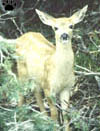
Mule deer fawn,
Grand Teton, Wyoming |
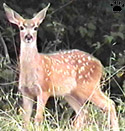
Mule deer fawn,
Lost Coast, California. |
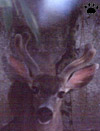
Deer looking in my
window, Berkeley. |

Mule deer fawn,
Lost Coast, California. |

Mule deer grazing,
North Rim, Arizona |
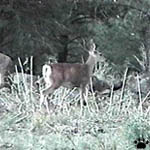 |
Its close relative, White-tailed deer,
a species of Eastern origin, is only common in some inland parts of the West.
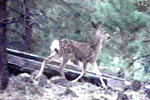 |
 |
| White-tailed deer (O.
virginianus), Dixie National Forest, Utah. |

Moose drinking, Liard Valley, British Columbia. |
In the North, moose (Alces americanus)
is the most common member of deer family. It occurs in boreal forests, southern
part of tundra, and also in high mountains and suburbs. |
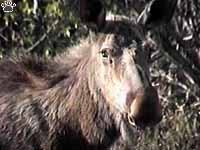
Moose, Muncho Lake Prov. Park, Brit. Col. |
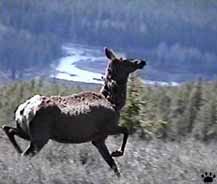
Elk, summit of Pink Mountain, British Columbia. |
Elk (Cervus canadensis) is
also locally common, particularly in the Rockies, but it can be difficult to see
outside parks and Nature reserves. |
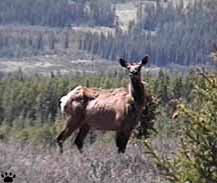
Elk, summit of Pink Mountain, British Columbia. |
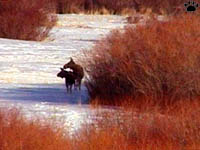 |
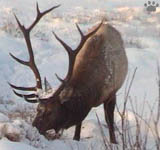 |
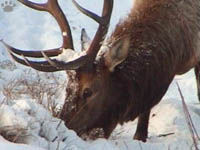 |
| Unlike European moose (Alces alces),
which mostly feeds on aspen (Populus tremulae) in winter, moose A. americanus
of America and Eastern Siberia prefer willows (Salix) as main winter food.
Rocky Mountains elk (Cervus canadensis nelsoni) also like willows. Northern
Colorado. |

Wolf and ravens,
Liard Valley, British Columbia. |
Wolves were once the most widespread carnivores
of North America. Ravens (Corvus corax) used to follow wolf packs in winter.
Now they depend on people for their survival. Western (Euro-American) culture
has a strange paranoid obsession with wolf, that can be traced back to medieval
times. |
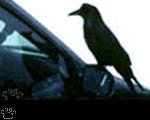
Raven playing with its reflection,
Yellowstone, Wyoming |
| Even now, hardly a week passes in the US without
at least one movie about werewolves and evil wolves in general. |

Wolf tracks,
Yellowstone, Wyoming. |
As a result, both wolf species have been almost
wiped out in USA (as well as in Mexico and most of Europe). |
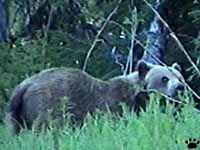
Grizzly bear (Ursus arctos horribilis),
Bear Glacier, British Columbia. |
Grizzly bears are also much feared and considered
very dangerous in the West, while black bears, being more common and widespread,
are more easily tolerated and considered harmless; both attitudes are a bit wrong. |

Black bear (U. americanus americanus),
Liard Valley, British Columbia. |

Rocky Mountains wood tick (Dermacentor andersoni), Roosevelt
Nat'l Forest, Colorado.
Part 15. The Great Plains
Back to Part 13
Home
|